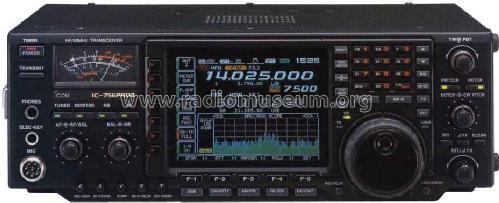
That effect is completely gone when the external ALC is used. Paul: If you listen to both files with headphones, you can hear the gritty artifacts that mimic the audio when the internal ALC is active.
#Icom 756 pro ii headphone jack type pro#
In the first file, the Pro III running stock audio and internal ALC is reaching approximatelly 60% modulation on peaks, and has come to the point where driving it harder results in heavy distortion. Note that in the second file, the Pro III, running with external ALC and audio processing, is reaching approximately 90% modulation on peaks fairly cleanly. To equal the playing field, I uploaded a clip made with the same receiver and bandwidth setting as the second link. Also, to be fair, that first file was not recorded on the same receiver, or at the same bandwidth as the second file. Pete: No, that is completely stock audio. Your readout is the first I've heard with any specific cause.Įven better, for those who run these rigs, that you've successfully proven out a fairly simple cure. Radio services in which these radios may be deployed, I am not sanguine thatīut with the prominent "rumble" I consistently heard on stations transmitting with the 756 series, I suspected it was a design shortcoming, not maladustment or isolated incidents. Nowadays, and the fact that A3E is not even an authorised emission for other Given the minority status of AM in the ARS Icom will not treat this as an action item unless a significant number of As the ADC and DAC used in the Icom radios are 24-bitĭevices originally intended for high-grade audio applications, I do notīelieve quantising distortion will be significant as long as the devices are

With any system involving A/D and D/A conversion, quantising distortion will The "rumble" in the receiver was due to modulation by the NB of the +8V railįeeding the low-level receive audio amplifiers. I've posted info about it on my AM Mode page at: I can run a much higher PEP with a lot less heat! The amp is much happier, though, and runs much cooler.

I guess this is partly determined by the detector used in the receiver of the receiving station. Listening to it on my Yaesu 901, it seems much cleaner, but I can't hear any difference on my Heathkit SB-301. When the 756 is modulated the amp produces about 600 watts pep, but runs very cool. I can now operate the rig at about 10 watts carrier, which drives the amp to about 150 watts.

I built the little curcuit from W8JI's page this afternoon. My amp (AL-82) would run about 350 watts carrier, and would fall back to about 85 watts or so when I would speak (still about 350 watts pep). When operating at 25 watts carrier from my 756, I was producing about 25 watts pep when modulated at 100% (because the power output would drop to about 8 watts!). In order to get decent power out, I would have to run my amp harder than I care when operating AM. Unlike my Yaesu 901 and Heathkit equipment, the output power of my 756 Icom would drop considerably when I would modulate the transmitter with voice. I've tried using my IC-756 on AM from time to time, as I enjoy this mode on 75, 40, 20, and 10 meters.


 0 kommentar(er)
0 kommentar(er)
